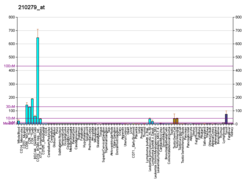N-Arachidonyl glycine receptor (NAGly receptor), also known as G protein-coupled receptor 18 (GPR18), is a protein that in humans is encoded by the GPR18 gene.[5][6] Along with the other previously orphan receptors GPR55 and GPR119, GPR18 has been found to be a receptor for endogenous lipid neurotransmitters, several of which also bind to cannabinoid receptors.[7][8][9] It has been found to be involved in the regulation of intraocular pressure.[10]
Research supports the hypothesis that GPR18 is the abnormal cannabidiol receptor and N-arachidonoyl glycine, the endogenous lipid metabolite of anandamide, initiates directed microglial migration in the CNS through activation of GPR18,[11] though recent evidence demonstrates that NAGly was not shown to be a GPR18 agonist in rat sympathetic neurons.[12]
Resolvin D2 (RvD2), a member of the specialized proresolving mediators (SPM) class of polyunsaturated fatty acid metabolites, is an activating ligand for GPR18; RvD2 and its activation of GPR18 contribute to the resolution of inflammatory responses as well as inflammation-based and other diseases in animal models and are proposed to do so in humans.[13] Furthermore, RvD2 is a metabolite of the omega-3 fatty acid, docosahexaenoic acid (DHA); the metabolism of DHA to RvD2 and RvD2's activation of GPR18 is proposed to one among many other mechanisms for the anti-inflammatory and other beneficial effects attributed to omega-3 fatty acid-rich diets[14]
- ^ a b c GRCh38: Ensembl release 89: ENSG00000125245 – Ensembl, May 2017
- ^ a b c GRCm38: Ensembl release 89: ENSMUSG00000050350 – Ensembl, May 2017
- ^ "Human PubMed Reference:". National Center for Biotechnology Information, U.S. National Library of Medicine.
- ^ "Mouse PubMed Reference:". National Center for Biotechnology Information, U.S. National Library of Medicine.
- ^ Gantz I, Muraoka A, Yang YK, Samuelson LC, Zimmerman EM, Cook H, Yamada T (Sep 1997). "Cloning and chromosomal localization of a gene (GPR18) encoding a novel seven transmembrane receptor highly expressed in spleen and testis". Genomics. 42 (3): 462–6. doi:10.1006/geno.1997.4752. PMID 9205118.
- ^ "Entrez Gene: GPR18 G protein-coupled receptor 18".
- ^ Kohno M, Hasegawa H, Inoue A, Muraoka M, Miyazaki T, Oka K, Yasukawa M (September 2006). "Identification of N-arachidonylglycine as the endogenous ligand for orphan G-protein-coupled receptor GPR18". Biochem. Biophys. Res. Commun. 347 (3): 827–32. doi:10.1016/j.bbrc.2006.06.175. PMID 16844083.
- ^ Burstein S (December 2008). "The elmiric acids: biologically active anandamide analogs". Neuropharmacology. 55 (8): 1259–64. doi:10.1016/j.neuropharm.2007.11.011. PMC 2621443. PMID 18187165.
- ^ Bradshaw HB, Lee SH, McHugh D (September 2009). "Orphan endogenous lipids and orphan GPCRS: A good match". Prostaglandins Other Lipid Mediat. 89 (3–4): 131–4. doi:10.1016/j.prostaglandins.2009.04.006. PMC 2740803. PMID 19379823.
- ^ Caldwell MD, Hu SS, Viswanathan S, Bradshaw H, Kelly ME, Straiker A (June 2013). "A GPR18-based signalling system regulates IOP in murine eye". British Journal of Pharmacology. 169 (4): 834–43. doi:10.1111/bph.12136. PMC 3687663. PMID 23461720.
- ^ Cite error: The named reference
pmid20346144was invoked but never defined (see the help page). - ^ Lu VB, Puhl HL, Ikeda SR (Jan 2013). "N-Arachidonyl glycine does not activate G protein-coupled receptor 18 signaling via canonical pathways". Molecular Pharmacology. 83 (1): 267–82. doi:10.1124/mol.112.081182. PMC 3533477. PMID 23104136.
- ^ Shinohara M, Serhan CN (2016). "Novel Endogenous Proresolving Molecules:Essential Fatty Acid-Derived and Gaseous Mediators in the Resolution of Inflammation". Journal of Atherosclerosis and Thrombosis. 23 (6): 655–64. doi:10.5551/jat.33928. PMC 7399282. PMID 27052783.
- ^ Calder PC (2015). "Marine omega-3 fatty acids and inflammatory processes: Effects, mechanisms and clinical relevance". Biochimica et Biophysica Acta (BBA) - Molecular and Cell Biology of Lipids. 1851 (4): 469–84. doi:10.1016/j.bbalip.2014.08.010. PMID 25149823.




